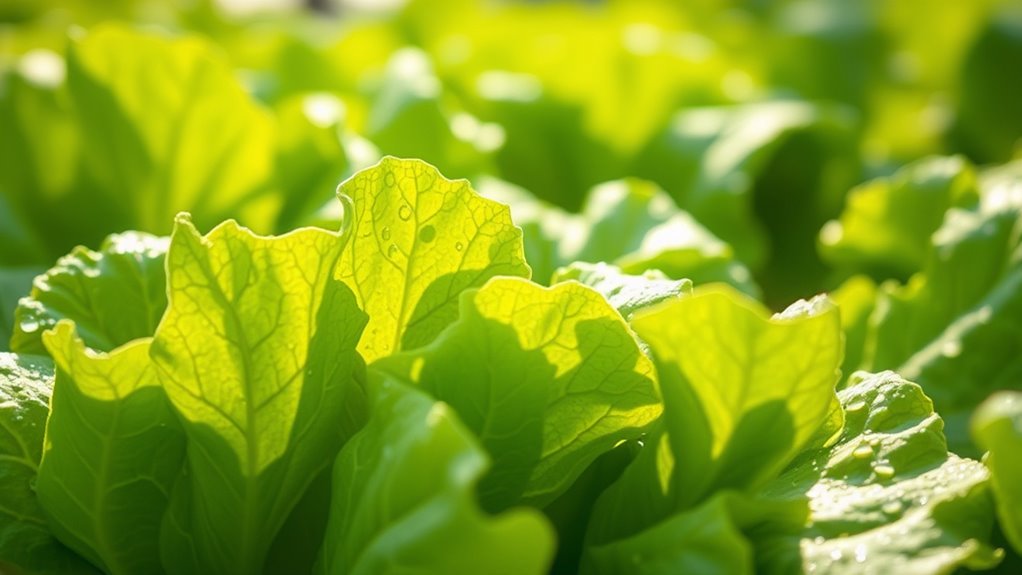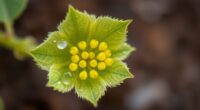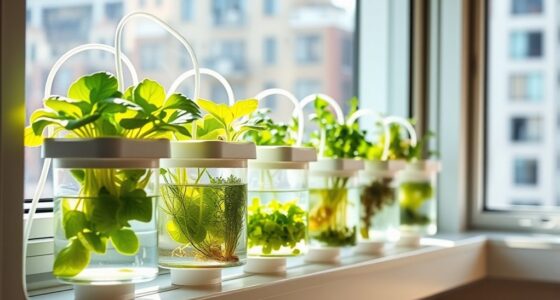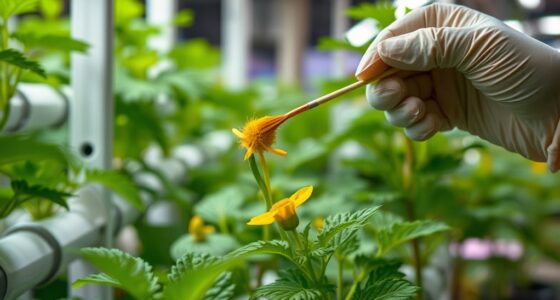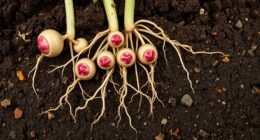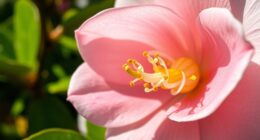To effectively feed your hydroponic plants through leaves, spray early in the morning or late afternoon when humidity is higher and temperatures are cooler. Use a fine mist to evenly cover both leaf surfaces without runoff, and add surfactants to improve absorption. Apply light, frequent doses rather than heavy spills for best results. Understanding proper timing, techniques, and conditions can maximize nutrient uptake—stay tuned to discover more tips for healthy, thriving plants.
Key Takeaways
- Foliar feeding is most effective during early morning or late afternoon when humidity and temperature favor absorption.
- Apply a fine mist to both leaf surfaces, avoiding heavy drips or runoff for optimal nutrient uptake.
- Use appropriate dilutions and surfactants to prevent leaf burn and improve nutrient spread.
- Supplement root feeding with foliar sprays during deficiencies or growth spurts for rapid nutrient delivery.
- Avoid spraying in direct sunlight or during peak heat to minimize leaf stress and maximize absorption efficiency.
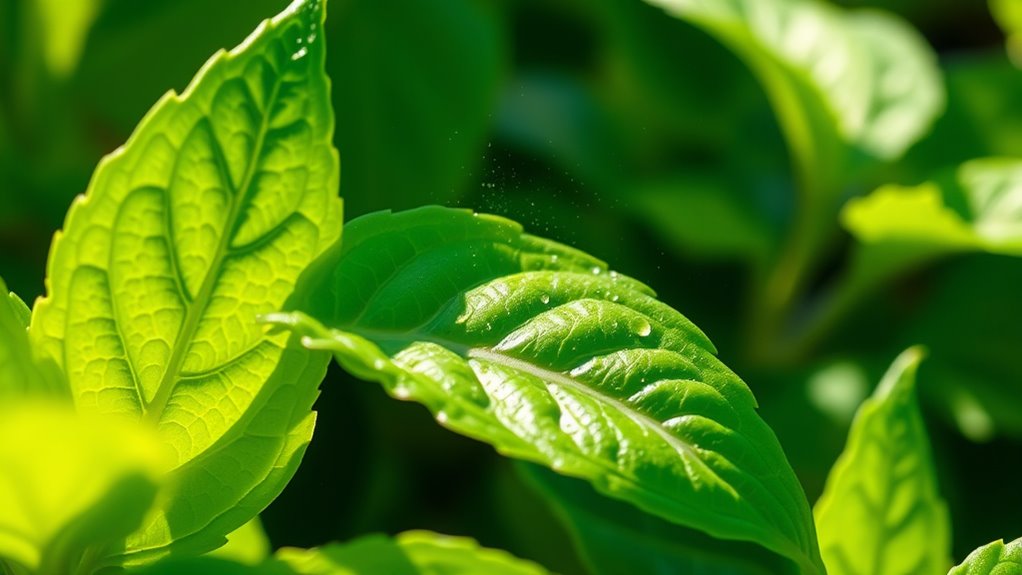
Foliar feeding in hydroponics offers a quick and efficient way to supply nutrients directly to plants through their leaves. When you spray nutrient solutions onto the foliage, you bypass the roots and deliver essential elements straight to where they’re needed most. This method is especially useful when plants show signs of nutrient deficiencies or when you need to boost growth rapidly. To maximize nutrient absorption, it’s important to understand how leaves uptake these nutrients and to use proper spray application techniques.
Foliar feeding delivers nutrients quickly through the leaves, bypassing roots for rapid plant health boosts.
Nutrient absorption through leaves occurs mainly via the stomata and the cuticle. While the cuticle is a waxy barrier that limits some absorption, many nutrients can penetrate through the stomata or diffuse across the leaf surface if conditions are right. Because of this, the timing of foliar applications is critical—applying during early morning or late afternoon when temperatures are cooler and humidity is higher can improve absorption. It also reduces the risk of leaf scorch due to rapid evaporation of the solution.
When it comes to spray application techniques, your goal is to ensure an even, fine mist that covers the entire leaf surface without runoff. Use a spray bottle or a fine mist sprayer to deliver a uniform layer of nutrient solution onto the leaves. Shake or agitate your sprayer regularly to prevent clogging, especially if you’re using powders or suspensions. Make sure to target both the upper and lower leaf surfaces because stomata are mostly located on the underside of leaves. Applying too much solution at once can cause runoff or clog stomata, which diminishes effectiveness. A light, frequent application schedule tends to work better than heavy, infrequent sprays.
To improve absorption, you can add a sticker or surfactant to your nutrient mix. These agents help the solution spread evenly and stay on the leaf surface longer, increasing the likelihood of nutrient uptake. Be cautious with the concentration; overly concentrated solutions can cause leaf burn or stress. Always follow recommended dilutions for foliar feeding, and avoid spraying during the hottest part of the day or when the sun is directly overhead. Additionally, understanding the structure of leaves can help optimize your foliar feeding techniques by targeting the most receptive areas for absorption.
In essence, successful foliar feeding in hydroponics hinges on understanding how the leaves absorb nutrients and mastering spray application techniques. When done correctly, foliar feeding can rapidly correct deficiencies, enhance overall plant health, and complement your hydroponic system by providing an immediate nutrient boost. With practice, you’ll find that this method becomes an invaluable tool in your plant care arsenal.
Frequently Asked Questions
Can Foliar Feeding Replace Root Nutrient Absorption Entirely?
You can’t rely solely on foliar feeding to replace root dependency because roots are essential for nutrient absorption and overall plant health. While foliar feeding provides quick nutrient uptake and can enhance nutrient synergy, it serves as a supplement rather than a replacement. Roots continuously supply a broad range of nutrients, supporting long-term growth, whereas foliar feeding offers immediate support during stress or deficiencies.
How Often Should Foliar Feeds Be Applied for Optimal Growth?
You’re asking about foliar feeding frequency for ideal growth. Think of it as a delicate dance—you don’t want to overdo it or underdo it. Usually, applying foliar feeds every 5-7 days works well, depending on plant needs and growth stage. Stick to these prime application intervals, and you’ll see healthier, more vigorous plants. Always monitor your plants and adjust the frequency if they show signs of stress or deficiency.
Are There Specific Nutrients That Are More Effective When Foliar Fed?
You might wonder if certain nutrients work better when foliar fed. In general, nutrients with high foliar nutrient specificity, like magnesium, iron, and micronutrients, are more effective due to leaf absorption efficiency. These nutrients are easily absorbed through the leaf surface, providing quick uptake. Avoid applying large amounts of nitrogen or phosphorus foliar sprays, as they’re less efficiently absorbed and could cause leaf damage.
What Are the Signs of Nutrient Deficiencies Detectable Through Foliar Feeding?
Think of deficiency symptoms as your plant’s cry for help. When you observe chlorosis detection, it’s a sign of nutrient deficiencies showing through pale or yellow leaves. You might also notice leaf curling, spots, or stunted growth—clear clues for deficiency symptoms. Using foliar feeding, you can quickly address these issues, providing nutrients directly through leaves to restore health. Stay vigilant, and your plants will thank you.
Can Foliar Feeding Be Used Safely on All Hydroponic Plant Varieties?
You wonder if foliar feeding is safe for all plant species. The truth is, foliar tolerance varies among plant types; some handle it well, while others may get leaf burn or stress. Always research your specific plant species first, and start with a diluted solution. If you notice any adverse reactions, cease immediately. Proper timing and careful observation ensure safe and effective foliar feeding for your hydroponic plants.
Conclusion
Foliar feeding in hydroponics offers a quick nutrient boost, especially when roots struggle or growth slows. Studies show that foliar applications can increase nutrient uptake efficiency by up to 60%, making it a powerful tool for healthy plants. Remember to spray during ideal times, like early morning or late afternoon, to avoid leaf burn. Incorporate foliar feeding wisely, and you’ll see healthier, more vigorous plants thriving in your hydroponic system.

